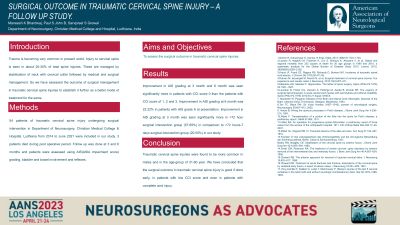SURGICAL OUTCOME IN TRAUMATIC CERVICAL SPINE INJURY – A FOLLOW UP STUDY.
Surgical Outcome in Traumatic Cervical Spine Injury – a Follow up Study
Friday, April 21, 2023


Paul John Bairappagari, MBBS, MS, MCh Neurosurgery (he/him/his)
Associate Professor of Neurosurgery
Christian Medical College and Hospital Ludhiana
Ludhiana, India
Presenting Author(s)
Introduction: Trauma is becoming very common in present world. Injury to cervical spine is seen in about 20-30% of total spine injuries. These are managed by stabilization of neck with cervical collar followed by medical and surgical management. So we have assessed the outcome of surgical management in traumatic cervical spine injuries to establish it further as a better mode of treatment for the same.
Methods: 54 patients of traumatic cervical spine injury undergoing surgical intervention in Department of Neurosurgery, Christian Medical College & Hospital, Ludhiana from 2014 to June 2021 were included in our study. 3 patients had mortality during post operative period. Follow up was done at 3 and 6 months and patients were assessed using AIS grading, bladder and bowel involvement and reflexes.
Results: Improvement in AIS grading at 3 month and 6 month was seen significantly better in patients with CCI score 0 than the patients with CCI score of 1, 2 and 3. Improvement in AIS grading at 6 month was 22.22% in patients with AIS grade A at presentation. Improvement in AIS grading at 3 month was seen significantly more in < 72 hour surgical intervention group (57.69%) in comparison to >72 hours-7 days surgical intervention group (20.00%) in our study.
Conclusion : Traumatic cervical spine injuries were found to be more common in males and in the age-group of 31-60 year. We have concluded that the surgical outcome in traumatic cervical spine injury is good if done at the earliest, in patients with low CCI score and even in patients with complete cord injury.
Methods: 54 patients of traumatic cervical spine injury undergoing surgical intervention in Department of Neurosurgery, Christian Medical College & Hospital, Ludhiana from 2014 to June 2021 were included in our study. 3 patients had mortality during post operative period. Follow up was done at 3 and 6 months and patients were assessed using AIS grading, bladder and bowel involvement and reflexes.
Results: Improvement in AIS grading at 3 month and 6 month was seen significantly better in patients with CCI score 0 than the patients with CCI score of 1, 2 and 3. Improvement in AIS grading at 6 month was 22.22% in patients with AIS grade A at presentation. Improvement in AIS grading at 3 month was seen significantly more in < 72 hour surgical intervention group (57.69%) in comparison to >72 hours-7 days surgical intervention group (20.00%) in our study.
Conclusion : Traumatic cervical spine injuries were found to be more common in males and in the age-group of 31-60 year. We have concluded that the surgical outcome in traumatic cervical spine injury is good if done at the earliest, in patients with low CCI score and even in patients with complete cord injury.
